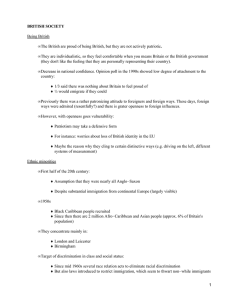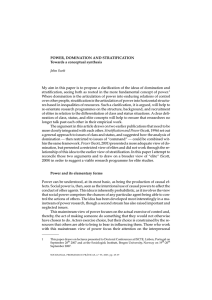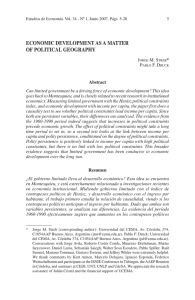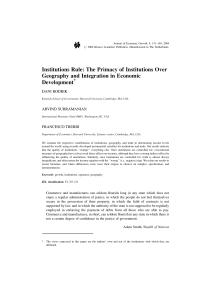De Facto Political Power and Institutional Persistence
Anuncio
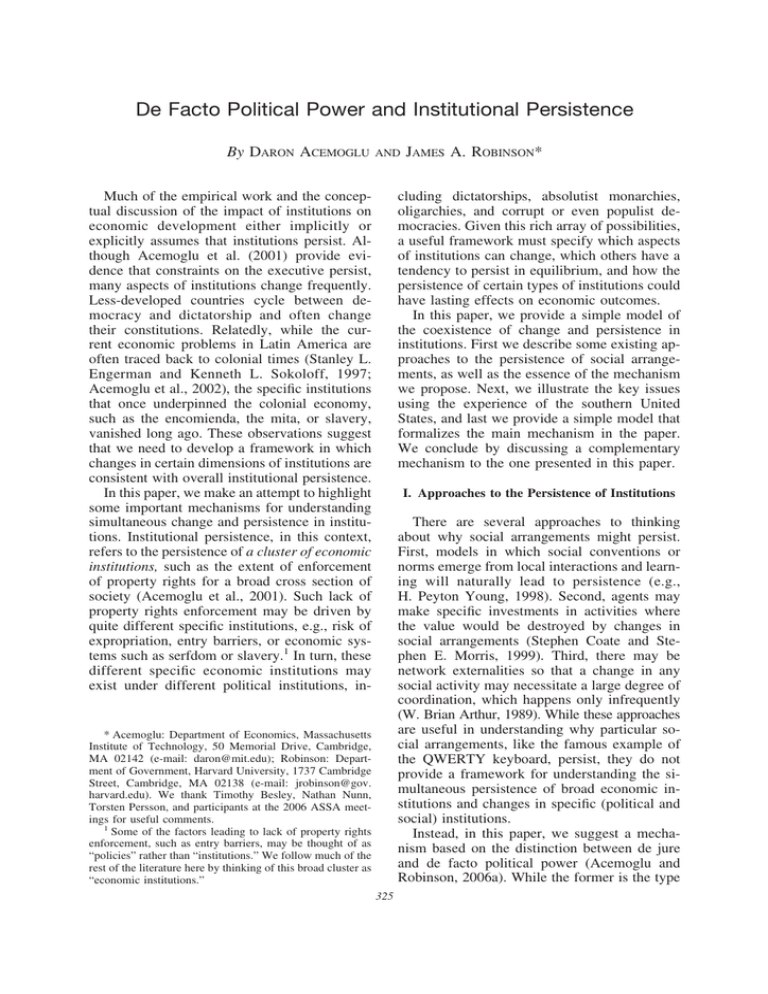
De Facto Political Power and Institutional Persistence By DARON ACEMOGLU AND JAMES Much of the empirical work and the conceptual discussion of the impact of institutions on economic development either implicitly or explicitly assumes that institutions persist. Although Acemoglu et al. (2001) provide evidence that constraints on the executive persist, many aspects of institutions change frequently. Less-developed countries cycle between democracy and dictatorship and often change their constitutions. Relatedly, while the current economic problems in Latin America are often traced back to colonial times (Stanley L. Engerman and Kenneth L. Sokoloff, 1997; Acemoglu et al., 2002), the specific institutions that once underpinned the colonial economy, such as the encomienda, the mita, or slavery, vanished long ago. These observations suggest that we need to develop a framework in which changes in certain dimensions of institutions are consistent with overall institutional persistence. In this paper, we make an attempt to highlight some important mechanisms for understanding simultaneous change and persistence in institutions. Institutional persistence, in this context, refers to the persistence of a cluster of economic institutions, such as the extent of enforcement of property rights for a broad cross section of society (Acemoglu et al., 2001). Such lack of property rights enforcement may be driven by quite different specific institutions, e.g., risk of expropriation, entry barriers, or economic systems such as serfdom or slavery.1 In turn, these different specific economic institutions may exist under different political institutions, in- A. ROBINSON* cluding dictatorships, absolutist monarchies, oligarchies, and corrupt or even populist democracies. Given this rich array of possibilities, a useful framework must specify which aspects of institutions can change, which others have a tendency to persist in equilibrium, and how the persistence of certain types of institutions could have lasting effects on economic outcomes. In this paper, we provide a simple model of the coexistence of change and persistence in institutions. First we describe some existing approaches to the persistence of social arrangements, as well as the essence of the mechanism we propose. Next, we illustrate the key issues using the experience of the southern United States, and last we provide a simple model that formalizes the main mechanism in the paper. We conclude by discussing a complementary mechanism to the one presented in this paper. I. Approaches to the Persistence of Institutions There are several approaches to thinking about why social arrangements might persist. First, models in which social conventions or norms emerge from local interactions and learning will naturally lead to persistence (e.g., H. Peyton Young, 1998). Second, agents may make specific investments in activities where the value would be destroyed by changes in social arrangements (Stephen Coate and Stephen E. Morris, 1999). Third, there may be network externalities so that a change in any social activity may necessitate a large degree of coordination, which happens only infrequently (W. Brian Arthur, 1989). While these approaches are useful in understanding why particular social arrangements, like the famous example of the QWERTY keyboard, persist, they do not provide a framework for understanding the simultaneous persistence of broad economic institutions and changes in specific (political and social) institutions. Instead, in this paper, we suggest a mechanism based on the distinction between de jure and de facto political power (Acemoglu and Robinson, 2006a). While the former is the type * Acemoglu: Department of Economics, Massachusetts Institute of Technology, 50 Memorial Drive, Cambridge, MA 02142 (e-mail: [email protected]); Robinson: Department of Government, Harvard University, 1737 Cambridge Street, Cambridge, MA 02138 (e-mail: jrobinson@gov. harvard.edu). We thank Timothy Besley, Nathan Nunn, Torsten Persson, and participants at the 2006 ASSA meetings for useful comments. 1 Some of the factors leading to lack of property rights enforcement, such as entry barriers, may be thought of as “policies” rather than “institutions.” We follow much of the rest of the literature here by thinking of this broad cluster as “economic institutions.” 325 326 AEA PAPERS AND PROCEEDINGS MAY 2006 of political power allocated by political institutions (such as constitutions or electoral systems), the latter emerges from the ability to engage in collective action, or use brute force or other channels such as lobbying or bribery. Equilibrium economic institutions are a result of the net effect (sum total) of these two sources of power. This observation opens the door for a model with a special form of hysteresis, in the sense that a given set of institutional arrangements will endure, even in the face of shocks and changes in specific institutions. (They may nonetheless collapse in response to a major reform or significant shock disturbing the entire equilibrium structure.) In the model presented here, there can be equilibrium changes in political institutions and thus de jure political power; but these induce offsetting changes in the distribution of de facto political power. Put differently, when elites who monopolize de jure political power lose this privilege, they may still exert disproportionate influence in politics by increasing the intensity of their collective action (e.g., in the form of greater lobbying, bribery, or downright intimidation and brute force), and thus ensure the continuation of the previous set of economic institutions. Why did the Southern Equilibrium persist? Despite losing the Civil War, antebellum political elites managed to sustain their political control of the South, particularly after reconstruction ended in 1877 and the last Northern troops left. They successfully blocked economic reforms that might have undermined this power, such as the distribution of 50 acres and a mule to each freed slave. They also derailed political reforms they opposed, and freed slaves were quickly disenfranchised through the use of literacy tests and poll taxes. Consequently, although slavery as an economic institution was abolished, Southern elites still possessed considerable de facto power through their control over economic resources, their greater education, and their relative ability to engage in collective action. As late as the 1940s, the South was still at only about 50 percent of the level of U.S. GDP per capita. It took a series of large technological, social, economic, and political shocks and reforms to demolish the Southern Equilibrium, including black migration to the North, the mechanization of cotton picking, the collective action of the civil rights movement, and the active intervention of the federal government. II. The Persistence of the Southern Equilibrium III. A Model One of the best examples of the persistence of economic institutions as a consequence of the persistence of de facto power comes from the southern United States. In the antebellum period, the South was relatively poor (about 70 percent of the national level of GDP per capita); had an urbanization rate of 9 percent as opposed to 30 percent in the Northeast; had relatively few railroads or canals; and was technologically stagnant (Gavin Wright, 1986). The economy was based on slavery and labor-intensive cotton production, and in many states it was illegal to teach slaves how to read and write. After the Civil War, with the abolition of slavery and the enfranchisement of the freed slaves, one might have anticipated a dramatic change in economic institutions. Instead, what emerged was a labor-intensive, low-wage, low-education, and repressive economy that in many ways looked remarkably like that of the antebellum South. Slavery was gone, but in its place were the Ku Klux Klan and Jim Crow (C. Vann Woodward, 1955). Consider a static version of the dynamic model analyzed in Acemoglu and Robinson (2006c). Society consists of a continuum 1 of workers and a finite number M of landowning elites (with the set of elites denoted by Ᏹ). There is a unique final good, and agents are risk neutral. The key decision is the form of labor market institutions (though any other choice of economic institutions affecting the rents of the elite would play the same role). Labor markets can either be competitive, with wages equal to marginal product, or monopsonistic, in which case wages are kept at a lower level. We denote economic institutions corresponding to competitive labor markets by ⫽ 1 and monopsony by ⫽ 0. With competitive labor markets, wages are higher and elites make profits normalized to 0, while under monopsony each member of the elite makes profits equal to R ⬎ 0. The only economic decision is the choice of 僆 {0, 1}. The political system is either democracy or VOL. 96 NO. 2 POLITICAL ECONOMY nondemocracy. With the former, denoted by S ⫽ D, de jure political power is more evenly distributed, so workers have greater say in the political process. With a nondemocratic system, S ⫽ N, the elite have greater de jure political power. In either system, however, collective decisions are made by the group with greater overall power, which is the composition of de jure and de facto. Since there is a large number of workers, the collective action problem among them precludes investing in systematic methods of increasing their de facto political power. In contrast, elites can invest to gather further de facto political power. We express the cost of this effort in terms of the final good. If elite agent i 僆 Ᏹ spends an amount i as a contribution to activities increasing their group’s de facto power, then the elite’s de facto political power will be (1) PE ⫽ 冘 327 decide their contributions { i } i僆Ᏹ, then is realized, and depending on whether P E ⱖ P C , the elite or the citizens decide . We look for the subgame perfect equilibrium of this game under democracy and nondemocracy. The equilibrium is straightforward to characterize because citizens do not take any important actions. Moreover, when the elite have greater political power, i.e., P E ⱖ P C , they choose ⫽ 0, and when the citizens have greater power, P E ⬍ P C , they choose ⫽ 1. Let us now look at the choice of i for elite agents. When all other elite agents choose { j (S)} j僆Ᏹ, j⫽i , and individual i 僆 Ᏹ chooses i , total elite power in regime S will be (3) P E 共 i , 兵 j 共S兲其 j僆Ᏹ, j⫽i 兩S兲 冉冘 ⫽ 冊 j(S) ⫹ i . j僆Ᏹ, j⫽i i i僆Ᏹ where ⬎ 0. Since there is a finite number, M, of elites, each will take into account that their own contribution to total spending affects equilibrium outcomes. On the other hand, the political power of the citizens is given by (2) P C ⫽ ⫹ I 共S ⫽ D兲 where I (S ⫽ D) is an indicator function for democracy, ⬎ 0, and is a random variable with a continuous distribution function F and a strictly decreasing density f (see Acemoglu and Robinson, 2006c, for generalizations). If PE ⱖ PC, the elite decide , otherwise the citizens decide . This formulation captures two important features. First, in democracy the citizens have relatively greater political power as captured by the parameter ⬎ 0. Second, the overall outcome of the contest between the citizens and the elite is uncertain because sometimes (subgroups of) citizens may be able to solve the collective action problem and exert greater political power (e.g., during periods of revolution or social unrest; see Acemoglu and Robinson, 2006a). The timing of events is simple: in both regimes, members of the elite simultaneously The elite will therefore have political power if (4) P E 共 i , 兵 j 共S兲其 j僆Ᏹ, j⫽i 兩S兲 ⱖ ⫹ I 共S ⫽ D兲. Consequently, in nondemocracy, agent i will choose i to maximize (5) 冉冉 冘 ⫺i ⫹ F 冊冊 j(N) ⫹ i R j僆Ᏹ, j⫽i where the first term is the cost of his contribution, and the second term is the probability of the elite having greater power than the citizens and thus each elite agent receiving the return from monopsony, R. The first-order condition for this problem implies: (6) 冉冉冘 f j (N) ⫹ i j僆Ᏹ, j⫽i and 冊冊 Rⱕ1 冘 共N兲 ⱖ 0, i i僆Ᏹ with complementary slackness. Since f is strictly decreasing, this first-order condition is also necessary. Moreover, when ¥i僆Ᏹ i(N) ⬎ 328 AEA PAPERS AND PROCEEDINGS 0, this first-order condition determines a unique level of ¥i僆Ᏹ i(N) such that 冉 冉 冘 冊冊 f (7) i (N) R ⫽ 1. i僆Ᏹ Next, similarly, in democracy, the problem facing elite agent i is 冉冉冘 (8) max ⫺ i ⫹ F i 冊 冊 j(D) ⫹ i ⫺ R, j僆Ᏹ, j⫽i which only differs from (5) because of the presence of the term , representing the greater de jure power of the citizens in democracy. By the same arguments, an equilibrium with ¥i僆Ᏹ i(D) ⬎ 0 satisfies (9) 冉 冉冘 冊 冊 f i (D) ⫺ R ⫽ 1. i僆Ᏹ The main result now follows: if there are positive contributions by the elite in their de facto power in both regimes, i.e., ¥i僆Ᏹ i(N) ⬎ 0 and ¥i僆Ᏹ i(D) ⬎ 0 (see Acemoglu and Robinson, 2006c, for conditions to ensure this type of interior equilibrium and generalizations), then (7) and (9) apply and imply that (10) 冉冘 冊 i (D) ⫺ ⫽ i僆Ᏹ 冉冘 冊 i (N) i僆Ᏹ and thus (11) 冉 冉冘 冊 冊 冉 冉 冘 冊冊 F i (D) ⫺ MAY 2006 voring the elite, Pr[ ⫽ 0], is independent of whether the political regime is democratic or nondemocratic.2 Moreover, it is straightforward to verify that the greater the rents from having monopsony in the labor market, R, the greater are the investments of the elite in their de facto power, and the greater is the likelihood that they will succeed in imposing their favorite economic institutions. Thus, ⭸ Pr[ ⫽ 0]/⭸R ⬎ 0. In addition, a better technology of generating de facto political power for the elite, i.e., higher , also increases Pr[ ⫽ 0], so that ⭸ Pr[ ⫽ 0]/⭸ ⬎ 0. The first suggests that alternative technologies that reduce the labor market rents of traditional landowners may weaken their grip on power, while the second shows that limits on the ability of the elite to exercise de facto power have the same effect. Both of these comparative statics may be useful in understanding the demise of the Southern Equilibrium discussed above, since this collapse was precipitated by mechanization of cotton picking, black migration, and the civil rights movement, which correspond to reductions in R and in the context of the model. The result that investment in de facto power exactly offsets the additional de jure power of the citizens in democracy is special (see Acemoglu and Robinson, 2006c). Nevertheless, this extreme result illustrates the main mechanism for the coexistence of change and persistence in institutions. Political institutions can change from nondemocracy to democracy, changing the distribution of de jure political power. But this may have little effect on (the equilibrium distribution of) economic institutions because now the elite invest more in their de facto political power, for example, in the form of bribing politicians, controlling the party system, lobbying, or using intimidation and force in order to obtain the type of economic institutions they desire. Thus, i僆Ᏹ ⫽F (N) . i i僆Ᏹ In other words, in democracy the elite invest sufficiently more in their de facto power to ensure the same probability of maintaining overall political power. Therefore, the (ex ante) probability of economic institutions fa- 2 An alternative formulation which gives identical results was suggested to us by Torsten Persson. Assume, instead, that 僆 [0, 1] instead of 僆 {0, 1}; ⫽ F( ¥i僆Ᏹ i) in nondemocracy; and ⫽ F( ¥i僆Ᏹ i ⫺ ) in democracy, where F : ⺢⫹ 3 [0, 1] is continuous, increasing and concave. It can be easily verified that, in this case, the maximization problem of each individual elite is maxiF( ¥i僆Ᏹ i) ⫺ i in nondemocracy and maxiF( ¥i僆Ᏹ i ⫺ ) ⫺ i in democracy. With the necessary boundary conditions, these maximization problems will again lead to identical equilibrium levels of . VOL. 96 NO. 2 POLITICAL ECONOMY change in specific political institutions can go hand in hand with persistence in economic institutions (here Pr[ ⫽ 0]). The model also clarifies the nature of the reforms and shocks that could change institutions more fundamentally—thus disrupting the pattern of hysteresis. While simply changing political institutions from nondemocracy to a democracy that can still be captured by the elite is generally not enough, reform on multiple dimensions (e.g., simultaneous reductions in R and ) may be much more effective. IV. Concluding Remarks The development experiences of many countries involve frequent changes in political institutions, constitutions, or even aspects of economic institutions, though certain broad aspects of economic institutions, such as the overall level of property rights enforcement or reliance on labor-repression in agriculture, endure. This paper presented a simple model that can account for the coexistence of change and persistence in institutions. The mechanism proposed here captures only some aspects of this coexistence. It nonetheless illustrates how the appearance of change in certain dimensions of specific institutions does not necessarily mean a change in economic institutions that are essential for the allocation of resources in society. While the mechanism in this paper is based on the persistence of de facto political power and emphasizes how the same elites are able to shape politics even when certain aspects of specific political institutions change, a complementary mechanism, which we refer to as the “Iron Law of Oligarchy” following Robert Michels’ (1911) classic book, focuses on how changes in the identity of elites can go hand in hand with the same dysfunctional policies and economic institutions. The reason for persistence is therefore not persistence of the elites, but the persistence of incentives of whoever is in power to distort the system for their own benefit. An oligarchic structure is one in which a group of agents monopolize political power and are difficult to displace because of the entrenchment afforded to them by the political institutions. The iron law of oligarchy emerges when the current elite are replaced by newcomers, sometimes with a popular mandate, and yet once these newcomers are in power they have no incentive to change 329 the oligarchic structure, and instead use the entrenchment provided by the existing political institutions for their own benefit. This model is useful in thinking about how the frequent changes in the identity of those who hold political power can go hand in hand with the continuation of disastrous policies. This pattern has been observed in many Latin American, Caribbean, and African countries, for example, in Bolivia, Ghana, Haiti, or Zimbabwe, which have all experienced significant changes in the identity of groups in political power combined with a surprising continuity in the types of policies and economic institutions (Acemoglu and Robinson, 2006b). We believe that investigations of these and other approaches to the coexistence of change and persistence in institutions constitute an important area for theoretical and empirical work in political economy. REFERENCES Acemoglu, Daron; Johnson, Simon and Robinson, James A. “The Colonial Origins of Compar- ative Development: An Empirical Investigation.” American Economic Review, 2001, 91(5), pp. 1369 –1401. Acemoglu, Daron; Johnson, Simon and Robinson, James A. “Reversal of Fortune: Geography and Institutions in the Making of the Modern World Income Distribution.” Quarterly Journal of Economics, 2002, 117(4), pp. 1231–94. Acemoglu, Daron and Robinson, James A. Economic origins of dictatorship and democracy. New York: Cambridge University Press, 2006a. Acemoglu, Daron and Robinson, James A. “A Model of the Iron Law of Oligarchy.” Unpublished Paper, 2006b. Acemoglu, Daron and Robinson, James A. “Persistence of Power, Elites and Institutions.” Unpublished Paper, 2006c. Arthur, W. Brian. “Competing Technologies, Increasing Returns, and Lock-In by Historical Events.” Economic Journal, 1989, 99(394), pp. 116 –31. Coate, Stephen and Morris, Stephen. “Policy Persistence.” American Economic Review, 1999, 89(5), pp. 1327–36. Engerman, Stanley L. and Sokoloff, Kenneth L. “Factor Endowments, Institutions, and Differential Paths of Growth among New World Economies: A View from Economic Historians 330 AEA PAPERS AND PROCEEDINGS of the United States,” in Stephen Haber, ed., How Latin America fell behind: Essays on the economic histories of Brazil and Mexico, 1800 –1914. Stanford: Stanford University Press, 1997, pp. 260 –304. Michels, Robert. Political parties: A sociological study of the oligarchical tendencies of modern democracy. (1911) Reprinted. New York: Free Press, 1962. MAY 2006 Woodward, C. Vann. The strange career of Jim Crow. Oxford: Oxford University Press, 1955. Wright, Gavin. Old South, new South: Revolu- tions in the Southern economy since the Civil War. New York: Basic Books, 1986. Young, H. Peyton. Individual strategy and social structure: An evolutionary theory of institutions. Princeton: Princeton University Press, 1998.
